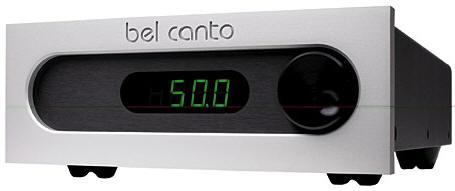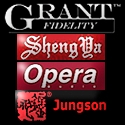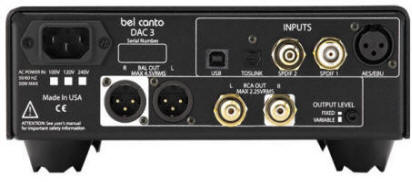
You are reading the older HTML site
Positive Feedback ISSUE
42march/april 2009
bel canto
e.One DAC3
as reviewed by Dave Clark

|
The Bel Canto e.One DAC3 has seen a lot of press over recent years and for very good reason, this is a very nice product that offers the music lover quite a lot for very little cash ($2495). At its paltry price when compared to the competition, the DAC 3 has as many options as a fully loaded BMW… this 24/192 marvel is based around the Burr-Brown PCM 1792 two-channel DAC chip (24-bit resolution) which is fed the bit-stream from the CS8421 Cirrus asynchronous sample-rate convertor chip. This, along with Bel Canto's Ultra-Clock circuit, provides very low jitter for the jittery jitter-phobic. Being fully balanced (which is how I ran it via either PAD Proteus Provectus or Kubala-Sosna Emotion interconnects) and offering just about any input short of I2S …in that you get USB, XLR AES/EBU, and S/PDIF (both Coax and Toslink) and all are galvanically isolated through various means (transformers and such) from the internal circuits to address noise and crap that can rain on your musical parade. The e.One DAC 3 does it any way you want it, and hey, it can even be used as a preamp via its variable out (controlled by the front-mounted rotary volume which also sets the various inputs and their outputs). Way cool.
And, depending upon which input is used, one can feed the e.One DAC3 any 'common' bit/sampling rate from a digital source (its USB limitation is 16/44.1 due to the use of the Cirrus Logic CS8416 receiver chip but it can handle up to to 24/96 via any of the other inputs) that your heart desires. Of course these are all upsampled automatically (which cannot be defeated if you are so wanting) to 24/192. Those wanting native 24/192 or even higher will have to go elsewhere or perhaps wait for the next generation of Bel Canto DACs if such a feature is in the cards. Sorry.
The e.One DAC3 is quite heavy for such a diminutive thing due no doubt to the robust power supply (two toroidal transformers and a bevy of choice parts that belie the DAC's price) and the more than adequate external audio bling casework; all which clearly suggests that the boys at Bel Canto are clearly ahead of the competition when it comes to offering a lot more for the cash-wise audio guy than found from the majority of the competing pack.
Of course this would all be for naught if the DAC was all show and no go… but …well, this thing has GO written over it… and in caps! Listening to the DAC 3 over an extended period of time with a wide range of Clark tunes, I continually found myself just listening to the music… and not to the DAC3. That is the DAC3 simply did nothing to say "Look at me!" "Look what I can do!" Nothing drew attention to itself: no bloat, no grain, no grit, no leanness, no over analysis of the details and minutiae for the analytically focused non-music listening listener, no nothing that raised its out-of-place head to make one listen to that instead of to this… and that be the music …one's music! The DAC 3 offered me an evenness to the sonic tapestry where the concept of linearity was obviously the goal of the Bel Canto collective. Quite refreshing it was. Honest and steady. No hype. No sonic burps to ruin a delightful evening. The DAC3 is truth in character.
Sure, the DAC3 is a bit softer at either end of the spectrum, but this is not something that I was really drawn towards when listening to whatever. The DAC3 just had a bit less at the extremes—less of what the bigger more elaborate and hence, way more costly alternative DACs possess that sets them apart from DACs in the more affordable e.Ones' price range. Okay, the DAC3 is perhaps a touch too smooth and maybe too soft at the top-end (one could easily say that this 'quality' is one of being more forgiving in nature, which is actually a nice thing to have in digital music reproduction and no... the DAC3 is not really recessed or rolled-off, there's just less 'sparkle') as opposed to possessing the ultimate in extension, detail, clarity, and air; such as realized in the other reference spinners in-house (those being the Cary 306 Professional, the EMM CDSA/SE, and the Playback Designs MPS-5). While these spinners are also smooth and silky, they just go farther and do it better than the DAC3. But then again they cost like what… oh yeah, like A LOT more than the DAC3. They also offer more apparent resolution than the DAC3, but if you ain't listening for it, you won't miss it. Squarely put, what the DAC3 presents is more than enough to get the music across to any listener. It is quite fine and I never found any of the music to be lacking really… anything of substance. Unless it went face-to-face with these reference players… but who in their right mind would do that?
At the other end of the spectrum, the DAC3 is not as ultimately extended nor does it have the dynamic slam or control found in any of the above players. That is, it will not do what they are capable of doing with the bass frequencies, but then again, and stay with me here… they cost 4 to 5 times as much as the DAC3 and yet the DAC3 still comes mighty close to their bottom-end presence, detail, and control! It gives up a bit, but that's fine as you won't miss it unless you already had it or at least had something to compare it to that did. Not a big deal really... this DAC plays music.
But, you do hope that you get something for all that additional investment one needs to move way up the digital ladder of diminishing returns and, well… you do with any of the wonderful players I have here. What's nice about the DAC3 is that even its omissions, they were never pointed out by some annoyingly obnoxious audio curmudgeon and then placed squarely in my lap for me to cry over. No the DAC3 just went along with its task of playing my music with as little fanfare as I could want… well there was fanfare, just not the kind that was of the 'off-putting' type—like I said above... the ubiquitous "Look what I can't or can do" sort of thing. There simply was no serious 'commissions' to complain about with the DAC3 in the system.
That said, the DAC3 has a killer soundstage that is deep, wide, and tall. This soundstage or soundfield is presented in a way that is, well … believable. It is not the least bit hi-fi-ish where it becomes more spectacular than real, nor is it one that is of the proverbial Technicolor-ish 3-D surround-o-smell-o-vision. Images have a presence that is simply quite tangible, something that you can hang your hat on. Sure the Playback Designs MPS-5 player's soundfield/soundstage is way bigger in every way, but that is that player's characteristic… it just sounds bigger and more open than anything I have heard! And sure the Cary 306 has more of that 'tube' quality than the competition, but then that is its characteristic… of which the DAC3 has none really. Characteristic that is. It is what it is.
With the DAC3 you get the detail and essence of the performance with nothing added to the mix that makes it seem to be artificial or, here it is again… to detract one from listening to what it is that you listen to—whether it be jazz, spazz, or whatever it is that defines your musical poison. The DAC3 does this 'portrayal of the event' quite well and as such it sounds quite right. Is it as 'real-like' as my reference players? Well… no, but again MAN… the price difference! Deal with it… they cost way, WAY more and paying more for these players clearly get you more, so stop with this questioning!
Then again, what if Bel Canto opened the engineering flood gates and really pushed the envelope in terms of a no-holds-barred design? One where price was an afterthought as opposed to one that shaped the final product? You guys at Bel Canto listening? Now that would be very interesting indeed.

I did my listening either through the USB (not as good, but quite acceptable and if they upgraded the DAC to reflect what they have achieved with their 24/96 USB Link… well then... hey now), the S/PDIF BNC via the Bel Canto 24/96 USB Link (which I found through the majority of listening to be way, WAY good; by itself the USB convertor is a clear recommendation for anyone looking to hear SOTA sound via any computer-based audio DAC needing such a device to connect things up) and the Toslink (which was also used quite a bit for my listening and was found to be almost as good as the BNC/Bel Canto USB Link… though it was still very, VERY good just the same) from my MacBook using various USB and Toslink cables (a variety of USB cables ranging from stock to the more exotic offerings from Cryo-Parts and Locus Design to optical cables like that from Van den Hul in their way nice Optocoupler Toslink). These various cables did make a difference, but like anything else in audio, it is all a matter of preference. I will say that the new Locus Design Nucleus USB cable is so wonderfully magnifique that it is as musically engaging as anything I have come across.
Without any of the above players to compare the DAC3 with I would have been quite a happy camper, but well… I have them here and compare we do. Even so, the DAC3 is a very beguiling performer that does what one wants… it puts the music first and itself second. But like I said, paying more will get you more… that's just the facts. You have to decide if that more is worth it. As it stands, for the price of the DAC3 there are only a few peers under $6000 that can offer this level of fit, finish, and sound!
Which lead to the question, "How does it compare to other like-priced DACs that I have had in house?" Well yeah, it does not 'sound' like the stellar NOS Redwine Isabellina in any way except that they are both very musical and enjoyable (the Isabellina is darker, warmer, richer, and more forgivingly 'colored' in the treble), but then the Isabellina has its limitations both in terms of flexibility and features—it can't do what the DAC3 can. Each has its own presentation and well, that's the joy of finding what mates with your tastes, music, and preferences. The e.One's character is more like that of not really having a character, and if that is what you want, as opposed to having more of this and less of that (can you say colorations...?), then the e.One should be on your short list of DACs to audition.
In the end, I found my time with the DAC3 to be quite enjoyable. It does nothing readily wrong unless you got the bigger boys to compare it with and even then it holds its own rather well. The DAC3 simply does so much right and at only $2495… it's a no-brainer. Highly recommended and with no reservations. Dave Clark
e.One DAC3
Retail $2495
Bel Canto
web address:
www.belcantodesign.com


